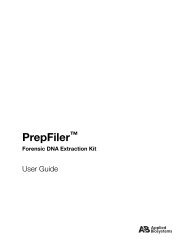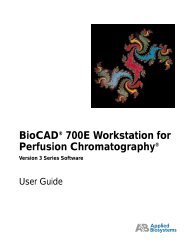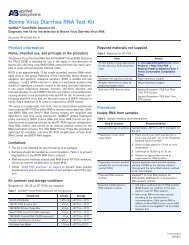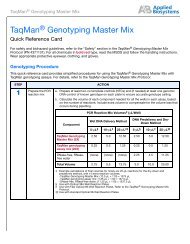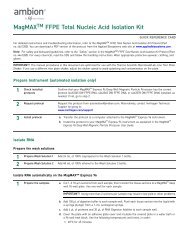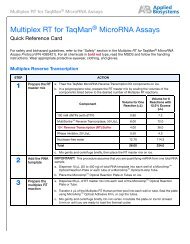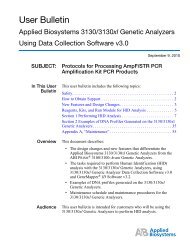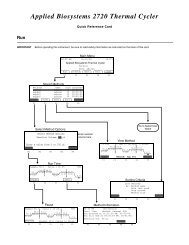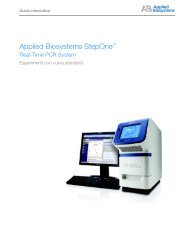AmpliTaq and AmpliTaq Gold DNA Polymerase - Applied Biosystems
AmpliTaq and AmpliTaq Gold DNA Polymerase - Applied Biosystems
AmpliTaq and AmpliTaq Gold DNA Polymerase - Applied Biosystems
Create successful ePaper yourself
Turn your PDF publications into a flip-book with our unique Google optimized e-Paper software.
Immun. 70(10): 5556-5561.http://iai.asm.org/cgi/content/abstract/70/10/5556Mycobacterium avium subsp. paratuberculosis <strong>and</strong> Mycobacterium avium subsp. avium areantigenically <strong>and</strong> genetically similar organisms; however, they differ in their virulence for cattle. M.avium subsp. paratuberculosis causes a chronic intestinal infection leading to a chronic wastingdisease termed paratuberculosis or Johne's disease, whereas M. avium subsp. avium causesonly a transient infection. We compared the response of bovine monocyte-derived macrophagesto ingestion of M. avium subsp. paratuberculosis <strong>and</strong> M. avium subsp. avium organisms bydetermining organism survival, superoxide <strong>and</strong> nitric oxide production, <strong>and</strong> expression of thecytokines tumor necrosis factor alpha (TNF-{alpha}), gamma interferon (IFN-{gamma}),interleukin-8 (IL-8), IL-10, IL-12, <strong>and</strong> granulocyte-monocyte colony-stimulating factor (GM-CSF).Unlike M. avium subsp. paratuberculosis, macrophages were able to kill approximately half of theM. avium subsp. avium organisms after 96 h of incubation. This difference in killing efficiency wasnot related to differences in nitric oxide or superoxide production. Compared to macrophagesactivated with IFN-{gamma} <strong>and</strong> lipopolysaccharide, macrophages incubated with M. aviumsubsp. paratuberculosis showed greater expression of IL-10 <strong>and</strong> GM-CSF (all time points) <strong>and</strong> IL-8 (72 h) <strong>and</strong> less expression of IL-12 (72 h), IFN-{gamma} (6 h), <strong>and</strong> TNF-{alpha} (6 h). Whencytokine expression by macrophages incubated with M. avium subsp. paratuberculosis wascompared to those of macrophages incubated with M. avium subsp. avium, M. avium subsp.paratuberculosis-infected cells showed greater expression of IL-10 (6 <strong>and</strong> 24 h) <strong>and</strong> lessexpression of TNF-{alpha} (6 h). Therefore, the combination of inherent resistance to intracellulardegradation <strong>and</strong> suppression of macrophage activation through oversecretion of IL-10 maycontribute to the virulence of M. avium subsp. paratuberculosis in cattle.Weijer, S., M. E. Sewnath, et al. (2003). "Interleukin-18 Facilitates the Early Antimicrobial Host Responseto Escherichia coli Peritonitis." Infect. Immun. 71(10): 5488-5497.http://iai.asm.org/cgi/content/abstract/71/10/5488To determine the role of endogenous interleukin-18 (IL-18) during peritonitis, IL-18 gene-deficient(IL-18 KO) mice <strong>and</strong> wild-type mice were intraperitoneally (i.p.) infected with Escherichia coli, themost common causative agent found in septic peritonitis. Peritonitis was associated with abacterial dose-dependent increase in IL-18 concentrations in peritoneal fluid <strong>and</strong> plasma. Afterinfection, IL-18 KO mice had significantly more bacteria in the peritoneal lavage fluid <strong>and</strong> weremore susceptible for progression to systemic infection at 6 <strong>and</strong> 20 h postinoculation than wildtypemice. The relative inability of IL-18 KO mice to clear E. coli from the abdominal cavity wasnot due to an intrinsic defect in the phagocytosing capacity of their peritoneal macrophages orneutrophils. IL-18 KO mice displayed an increased neutrophil influx into the peritoneal cavity, butthese migratory neutrophils were less activate, as reflected by a reduced CD11b surfaceexpression. These data suggest that endogenous IL-18 plays an important role in the earlyantibacterial host response during E. coli-induced peritonitis.Eitel, J. <strong>and</strong> P. Dersch (2002). "The YadA Protein of Yersinia pseudotuberculosis Mediates High-Efficiency Uptake into Human Cells under Environmental Conditions in Which Invasin IsRepressed." Infect. Immun. 70(9): 4880-4891.http://iai.asm.org/cgi/content/abstract/70/9/4880The YadA protein is a major adhesin of Yersinia pseudotuberculosis that promotes tight adhesion



